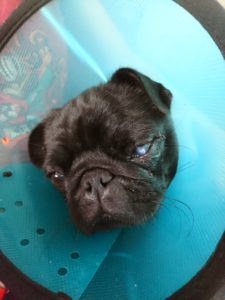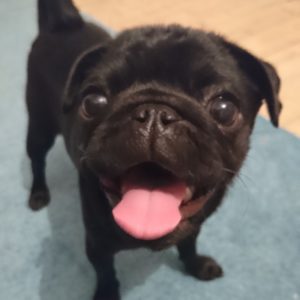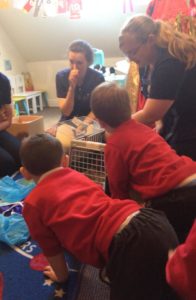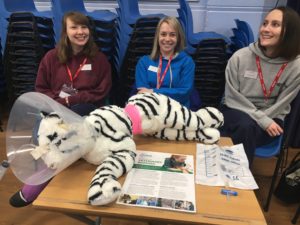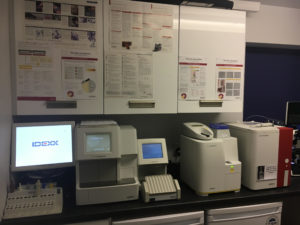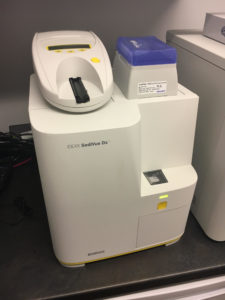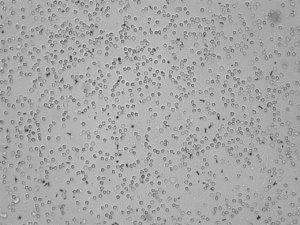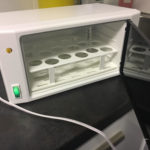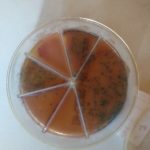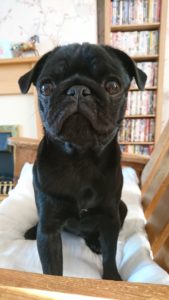 Savanna is a bouncy black 14 month old Pug who presented due to discharge and a glazed appearance in her left eye. As a typical young dog she is lively and loves playing so her owner suspected she had caught it on a toy. With this history however it was important to look for a corneal ulcer.
Savanna is a bouncy black 14 month old Pug who presented due to discharge and a glazed appearance in her left eye. As a typical young dog she is lively and loves playing so her owner suspected she had caught it on a toy. With this history however it was important to look for a corneal ulcer.
A corneal ulcer is a term used to describe damage and destruction of cells on the surface of the cornea. The damage can be very small and superficial but some ulcers can extend deep into the cornea and involve a large proportion of the corneal surface. Treatment is needed straight away as some corneal ulcers can be problematic to heal and deteriorate quickly. Unfortunately, this can be very true for certain breeds and Pugs are one of them!
 There are lots of reasons for their occurrence; trauma/abrasion or ocular foreign bodies, chronic irritation from face hairs or abnormal eyelashes, structural issues with the eyelids, reduced production of tears and many more! It is important that in the diagnosis of an ulcer that any of these issues are looked for and addressed; without this the ulcer will struggle to heal as hard as we try!
There are lots of reasons for their occurrence; trauma/abrasion or ocular foreign bodies, chronic irritation from face hairs or abnormal eyelashes, structural issues with the eyelids, reduced production of tears and many more! It is important that in the diagnosis of an ulcer that any of these issues are looked for and addressed; without this the ulcer will struggle to heal as hard as we try!
Savanna did have a corneal ulcer in the centre of her left eye. No other structural issues were identified which was good. Breeds with prominent eyes are naturally at higher risk of catching the surface on objects so it was possible this was the case for Savanna.
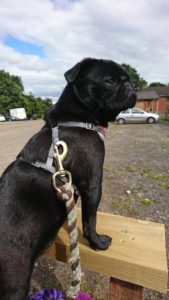 Initial treatment of an ulcer involves supporting the eye and patient whilst the eye itself heals naturally. This involves antibiotic eye drops to prevent and protect from infection, lubricating drops to help keep the ocular surface healthy and oral pain relief as corneal ulcers are very painful. Lastly, a cone of shame is needed to prevent patient interference as our furry patients are prone to rubbing and scratching their painful eyes. Pugs have been described to have poor corneal sensation so even simple traumatic corneal ulcers like Savanna’s can have poor healing and response to medical therapy.
Initial treatment of an ulcer involves supporting the eye and patient whilst the eye itself heals naturally. This involves antibiotic eye drops to prevent and protect from infection, lubricating drops to help keep the ocular surface healthy and oral pain relief as corneal ulcers are very painful. Lastly, a cone of shame is needed to prevent patient interference as our furry patients are prone to rubbing and scratching their painful eyes. Pugs have been described to have poor corneal sensation so even simple traumatic corneal ulcers like Savanna’s can have poor healing and response to medical therapy.
Some seemingly simple ulcers can also develop into what are described as ‘melting ulcer’s’. This is when the ulcer deteriorates rapidly and the surrounding cornea becomes soft and jelly like. They are usually associated with specific bacteria, Pseudomonas. They require aggressive medical management and can quickly result in rupture of the eye. Any untreated or complicated ulcer can in fact lead to perforation/rupture of the cornea which is why timely diagnosis and treatment is important.
Savanna started medical management that evening on the caveat should the eye deteriorate we may need to change our medical approach or that in some cases surgery is required.
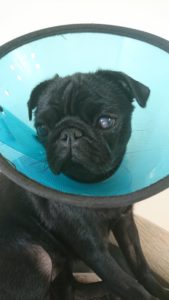 That evening the eye became suddenly more painful and seemed to leak fluid. Her owners followed our advice and contacted our emergency line. We decided to see Savannah straight away as we were worried about rupture. Our concerns were confirmed and we admitted Savannah overnight for lots of additional pain relief and ongoing assessment. In some of these cases the eye can be salvaged with specialist and intricate surgery and Specialist ophthalmologists are best placed for this type of surgery. However, surgical repair isn’t always possible or successful and in some cases surgical removal of the eye is required.
That evening the eye became suddenly more painful and seemed to leak fluid. Her owners followed our advice and contacted our emergency line. We decided to see Savannah straight away as we were worried about rupture. Our concerns were confirmed and we admitted Savannah overnight for lots of additional pain relief and ongoing assessment. In some of these cases the eye can be salvaged with specialist and intricate surgery and Specialist ophthalmologists are best placed for this type of surgery. However, surgical repair isn’t always possible or successful and in some cases surgical removal of the eye is required.
As Savannah was so young Richard and her owners decided to try and salvage the eye with ophthalmic surgery here at Hollybank and if this failed to work remove the eye as a last resort. The surgery is described as a conjunctival pedicle graft which means a shallow piece of conjunctiva is taken from the side of the eye and placed like a graft over the perforation (hole) in the cornea.
The surgery went successfully and Savanna’s eye began to show signs of healing. Despite a surgical approach Savanna still needed ongoing medical management (as described above) and this took lots of time, patience and dedication from her lovely owners!
Despite some shrinking and mild detachment of the graft Savanna’s eye continued to heal and over the next 4-6 weeks she made a full recovery with full vision! In some cases there can be residual scarring which can interfere with the visual axis but as you can see Savanna’s eye looks no different! We are delighted that we were able to save Savanna’s eye sand we hope she stays out of further trouble!

